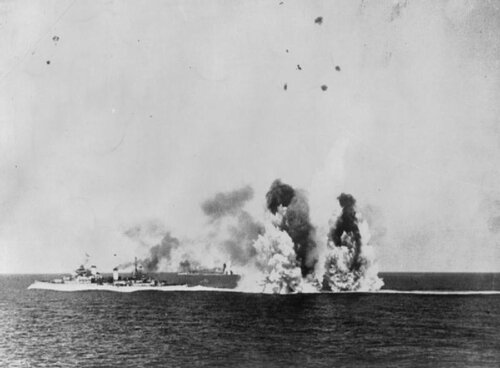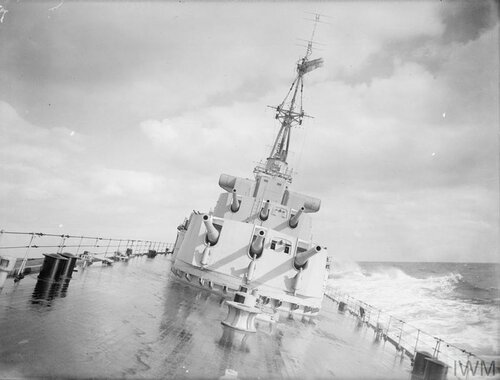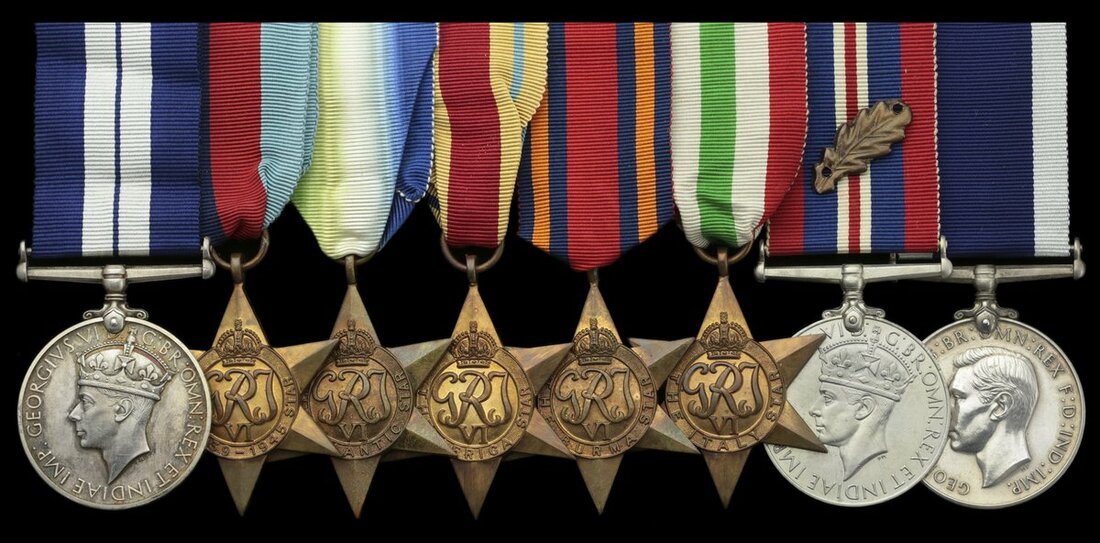Auction: 21002 - Orders, Decorations and Medals
Lot: 210
A fine 1945 D.S.M. group of eight awarded to Chief Yeoman of Signals A. Weston, Royal Navy, who served aboard Kenya during the Second World War - the gallant Weston earned a brace of 'mentions' for Operations Harpoon & Pedestal to go with his D.S.M. by War's end
Distinguished Service Medal, G.VI.R. (C.Y.S. A. Weston. D/J. 97337), officially engraved naming; 1939-45 Star; Atlantic Star; Africa Star; Burma Star; Italy Star; War Medal 1939-45, with M.I.D. oak leaf; Royal Navy L.S. & G.C., G.VI.R. (J.97337 A. Weston. C.Y.S. H.M.S. Drake.), good very fine (8)
D.S.M. London Gazette 14 June 1945.
Arthur Weston was born at Leith, Edinburgh on 2 February 1905 and was an engine apprentice upon his joining the Royal Navy as Boy Class II on 7 May 1920. Weston was appointed Chief Yeoman of Signals on 7 April 1939 and awarded his L.S. & G.C. on 19 December 1939. The Medal was presented, together with his gratuity on 30 January 1940 and he joined Kenya on 28 August 1940. Kenya was a cruiser which won battle honours for Atlantic 1941, the Bismarck Action 1941, Malta Convoys 1941-42, Arctic 1941-42, and Norway. Weston didn't he have to wait long for his share of action, for at the end of 1941 she was present in the Combined Operations raid on Vaasgo, where she was twice hit but only slightly damaged.
However, as stated above, he won his first M.I.D. for the Battle of Pantelleria in mid-June 1942 (London Gazette 22 September 1942, refers). The recommendation for that award states:
'Skilful and unflagging devotion to duty over a prolonged period of three days and three nights in dealing with all communications as a result of which the Force could be manoeuvred as a while in avoiding enemy air attacks.'
It was for his subsequent deeds on the Malta run in August 1942 that he was awarded the second (London Gazette 10 November 1942, refers), that recommendation stated:
'His unfailing and continued efficiency on the fore-bridge added greatly to the general control and manoeuvre of the convoy and forces in emergencies. Similar conduct and efficiency has been displayed in previous actions when he was entirely responsible for the V/S Staff.'
While the importance of the “Pedestal” operation needs no introduction here, it is worth recalling the bare facts: of the 14 merchantmen that set out, nine were sunk and three damaged, while the Senior Service lost an aircraft carrier, a cruiser and a destroyer, as well as having another half a dozen ships damaged, including the Kenya. A summary of the latter’s experiences in that momentous operation is also to be found in The King’s Cruisers:
‘Two months later Vice-Admiral Curteis hoisted his flag in the Kenya, and there was another exciting episode on the Malta run. It did not compare, however, with the next one, which was the grimly fought battle that got the remains of a convoy, including the famous tanker Ohio, through to Malta after the aircraft carrier Eagle and the cruiser Manchester had been sunk. The ships were subject to all forms of attack, including parachute mines, and U-Boats were in constant attendance. When four torpedoes were aimed at the Kenya, two missed, one passed right under the ship and the last struck the bows on the port side. The Admiral signalled: “Are you all right?” and received the reply, “Torpedoed forward but quite happy!” Five of the fourteen ships of the convoy got through and the Kenya, escorting them all the way, fought for eight hours continuously as she steamed west again for Gibraltar. Late on the afternoon of 14 August, four enemy planes were shot down in as many minutes and as the cruiser reached Gibraltar, the Admiral signalled, “You have shown a devotion to duty which has never been excelled and I shall always remember this force with pride.” At Scapa, ten days later, she was cheered into harbour by the Fleet while the flagship hoisted the three-word signal from the Commander-in-Chief, “Well done Kenya.” Further recognition came in the award of a D.S.O. to Captain Russell and three D.S.Ms and seven Mentions in Despatches [Weston included] to members of the ship’s company.’
Weston, who latterly added the D.S.M. to his laurels, was released on 8 November 1945; sold together with riband bar cut from his tunic and copied service records.
Subject to 20% VAT on Buyer’s Premium. For more information please view Terms and Conditions for Buyers.
Sold for
£2,100
Starting price
£600









